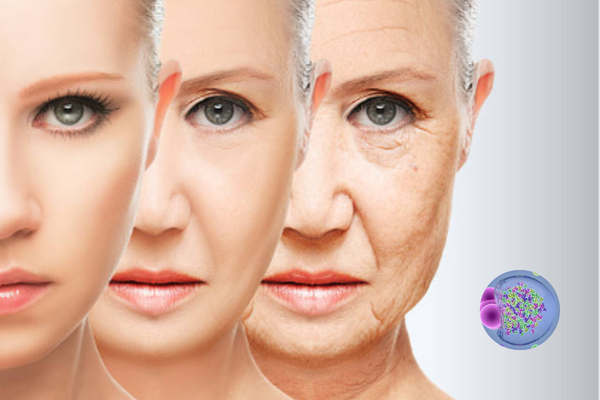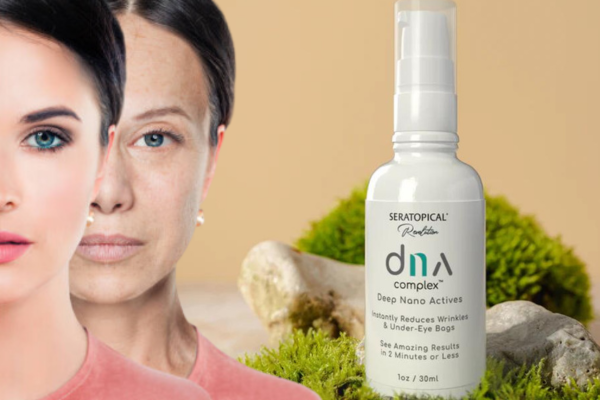The two biggest skincare challenges are aging and UV damage. Conventional therapies concentrate on superficial problems, but scientific discoveries have opened the door to the possibility of something far more profound: DNA repair. By tackling the damage at the core of aging—our DNA—this new science promises to not only slow down but also partially cure the ravages of aging. In this blog article, we will discuss the idea of DNA repair in skincare, how it functions, and why it might hold the secret to glowing, youthful skin.

The role of DNA in skin aging
It’s critical to comprehend the function of DNA in skin health before delving into DNA repair.DNA maps every structure and function of the body, including the skin. Our DNA can get mutated or damaged over time due to a variety of circumstances, including sun exposure, environmental contaminants, and even aging itself.
When the DNA in our skin cells becomes damaged, it can lead to a variety of issues. The most immediate consequence is the breakdown of collagen and elastin, the proteins responsible for keeping our skin firm and elastic. As these proteins degrade, signs of aging such as wrinkles, fine lines, and sagging skin become more apparent. Moreover, DNA damage can result in uneven pigmentation, dark spots, and an increased risk of skin cancer.
The Science of DNA Repair
Our bodies naturally repair damaged DNA regularly. Our cells come into contact with tens of thousands of DNA damage each day. Fortunately, our cells are equipped with complicated repair systems that can repair the majority of this damage. But as we get older, these repair mechanisms become less effective, which causes damage that cannot be fixed to build up.
The focus of skincare research has shifted to improving the body’s inbuilt DNA repair mechanisms in recent times. It is possible to both stop new damage and repair part of the existing damage that leads to aging and skin degradation by enhancing DNA repair mechanisms
The types of DNA damage in the skin
There are various ways that DNA damage can happen, and each has a unique effect on the skin:
- 1. UV-Induced Damage: UV rays from the sun are the main source of DNA damage to the skin. In particular, UVB rays can directly damage DNA, resulting in mutations that age the skin and increase the risk of cancer.
- 2. Oxidative Stress: Smoking and pollution produce free radicals, two environmental conditions that damage DNA This oxidative stress causes inflammation and other skin problems in addition to quickening the aging process.
- 3. Telomere Shortening: The protective caps at the ends of chromosomes are called telomeres. These telomeres shorten during cell division, which ultimately causes cellular aging and death. Skin elasticity loss and wrinkles are two obvious indicators of aging that are linked to shortened telomeres.
How DNA Repair Ingredients Work in Skincare
Several substances have been found to improve DNA repair in the skin. These substances function by either enhancing the body’s healing mechanisms or by giving the skin the resources it needs to more successfully repair DNA damage. These are a few of the most exciting new compounds in skincare products that repair DNA.
- Photolyase: The enzyme is found in numerous naturally occurring creatures, including plants and some animals, and it is essential for repairing DNA damage caused by UV rays. Photolyase is a component in skincare products designed to lessen the effects of solar exposure and stop additional damage.
- Endonucleases: These enzymes identify and cut off broken DNA segments so that the cell can reassemble the affected regions with the appropriate sequences. Endonucleases can be added to skincare formulas to target particular kinds of DNA damage and improve the skin’s ability to heal itself.
- Vitamin B3 (nicotinamide): Strong antioxidant nicotinamide also promotes DNA repair. It functions by giving cells the energy they need to repair damaged DNA and aids in UV damage prevention, which makes it a well-liked component in anti-aging and sunscreen solutions.
- Peptides: A few peptides can stimulate the body’s own DNA repair enzymes. These peptides can be used in skincare products to encourage DNA repair and improve the general health of the skin.
Resveratrol: Resveratrol, a strong antioxidant present in grapes, has been demonstrated to possess the ability to repair DNA. It prolongs the life of cells and shields them from oxidative damage, which slows down the aging process.
Benefits of DNA Repair in Skincare
Beyond superficial benefits, DNA repair has many other advantages in skincare. This is how skin can be transformed by DNA repair:
Diminished Outward Indicators of Aging: skincare products can lessen the appearance of fine lines, wrinkles, and sagging skin by repairing DNA damage. As a result, you seem younger and more rested.
Harmonious Skin Tone: Sun damage-related uneven pigmentation and black patches can be corrected with DNA repair chemicals. This may eventually result in a more consistent complexion.
Preventing Future Harm: Improving DNA repair enhances the skin’s defenses against future harm in addition to treating current damage. For people who are frequently exposed to the sun or other environmental stresses, this is especially crucial.
Enhanced Health of the Skin: Skin cells with healthy DNA are healthier. This results in enhanced hydration, suppleness, and resilience of the skin as well as greater overall function.
Reduced Skin Cancer Risk: DNA repair skincare products can lower the chance of getting skin cancer, especially in people with a history of heavy sun exposure, by repairing DNA damage before it results in mutations.

A Skincare Routine That Incorporates DNA Repair
It’s not necessary to completely change your skincare routine to include DNA repair. The following actions will get you going:
Seek for Products that Contain Ingredients Proven to Repair DNA: Look for skincare products with substances like nicotinamide, photolyase, endonucleases, peptides, and reinvested alkaloids. These components are frequently seen in creams, serums, and sunscreens.
Put Sun Protection First: Using broad-spectrum sunscreen daily is essential because UV radiation is one of the main causes of DNA damage. For further protection, think about using sunscreens that also have DNA repair enzymes.
Include antioxidants: These can help prevent DNA damage by lowering oxidative stress and neutralizing free radicals. Seek for goods that have resveratrol together with vitamins C and E.
Use Products Regularly: Since DNA repair is a continuous process, it is essential to use products containing DNA repair chemicals consistently if you want to see benefits. For best results, include these products in your nightly and morning regimens.
Speak with a Dermatologist: See a dermatologist if you’re not sure whether products are appropriate for your skin type and issues. They can suggest particular goods and therapies that will best meet your requirements.
The Future of DNA Repair in Skincare
Although DNA repair in skincare is still in its infancy, there is a lot of promise. We may anticipate increasingly more sophisticated formulations with stronger anti-aging effects that target particular kinds of DNA damage as research progresses.
DNA repair has the potential to be incorporated into all skincare regimens in the future, providing a more potent defense against the damaging effects of aging and the environment. As biotechnology continues to progress, customized DNA repair therapies that are catered to each person’s particular genetic composition and skin issues may also become accessible.
Conclusion
Since DNA repair targets the underlying causes of aging and UV damage, it provides a novel approach to skincare. DNA repair components provide a promising means of achieving youthful, healthy skin that is not only more impervious to future damage but also looks better by boosting the skin’s natural ability to repair itself. Adopting this scientifically proven method could be the key to keeping beautiful skin at any age as more products with DNA repair technology become accessible.
